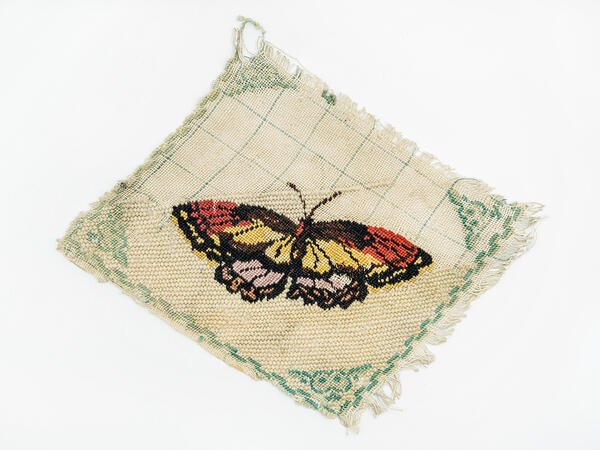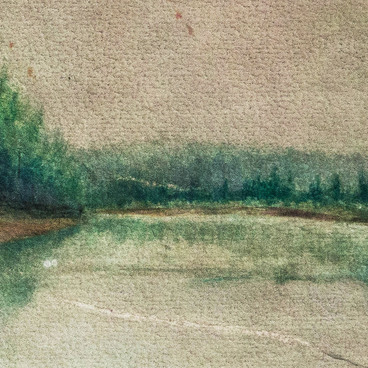The collection of the house-museum contains an unfinished embroidery “Butterfly”, which was made by Anna Mamina, the mother of the writer Dmitry Mamin-Sibiryak. In the center of the piece is a butterfly, embroidered with dense tapestry stitch using colored wool threads: black, red, yellow, pink, brown, blue and white. The embroidery is decorated with a blue border along the edges.
In the house where the museum is located, Anna Mamina lived the last 25 years of her life, from 1885 to 1910. One of the parts of the exhibition is her room with the reconstructed furnishings of the 19th century. On the table, there is a family album with photographs, letters, receipts of money transfers from his son, and hand embroidery on a small piece of a white translucent fabric.
On the floor of the room, there is a rug, bought by the mistress of the house, on the wall, there are portraits of her children, grandchildren, and husband — Narkis Mamin, and there is a small table near the window. At this table, Anna Mamina was usually engaged in needlework. She embroidered in various techniques — cross stitching, beadwork, satin stitching — and also crocheted and sewed.
The writer Dmitry Mamin-Sibiryak left this house in 1891 for St. Petersburg. His brothers, sister, nephews, and mother remained here. He always maintained a close relationship with her, despite the distance.
After his departure, Mamin-Sibiryak wrote letters to his mother on a weekly basis. Each envelope he signed “To Her High Honor A. S. Mamina”. In total, the archives have more than 450 letters from Dmitry Mamin-Sibiryak, which he sent to his mother in different years. Her son shared everything with her: creative plans, experiences, family joys and problems.
Anna Mamina died in 1910, at the age of 79. The writer could not come to the Urals for his mother’s funeral and was very worried about that.
In the house where the museum is located, Anna Mamina lived the last 25 years of her life, from 1885 to 1910. One of the parts of the exhibition is her room with the reconstructed furnishings of the 19th century. On the table, there is a family album with photographs, letters, receipts of money transfers from his son, and hand embroidery on a small piece of a white translucent fabric.
On the floor of the room, there is a rug, bought by the mistress of the house, on the wall, there are portraits of her children, grandchildren, and husband — Narkis Mamin, and there is a small table near the window. At this table, Anna Mamina was usually engaged in needlework. She embroidered in various techniques — cross stitching, beadwork, satin stitching — and also crocheted and sewed.
The writer Dmitry Mamin-Sibiryak left this house in 1891 for St. Petersburg. His brothers, sister, nephews, and mother remained here. He always maintained a close relationship with her, despite the distance.
After his departure, Mamin-Sibiryak wrote letters to his mother on a weekly basis. Each envelope he signed “To Her High Honor A. S. Mamina”. In total, the archives have more than 450 letters from Dmitry Mamin-Sibiryak, which he sent to his mother in different years. Her son shared everything with her: creative plans, experiences, family joys and problems.
Anna Mamina died in 1910, at the age of 79. The writer could not come to the Urals for his mother’s funeral and was very worried about that.



